Individual Report: Evaluating Communication at Mr Fishy Restaurant
VerifiedAdded on 2021/02/20
|8
|2251
|254
Report
AI Summary
This individual report analyzes communication practices at Mr. Fishy, a fish and chip restaurant. It begins with a literature review covering the purposes and principles of organizational communication, including oral and written forms. The report then explores principles of effective communication, identifying barriers such as language and cultural differences, and proposes strategies to overcome these challenges, such as clear and concise communication and understanding cultural nuances. The report evaluates current communication practices, highlighting strengths like skilled communication and weaknesses such as information overload and overlooking cultural backgrounds. The analysis discusses the application of these principles and theories within Mr. Fishy, and concludes with recommendations for improving overall communication effectiveness, emphasizing the importance of clear, consistent, and culturally sensitive communication for achieving organizational goals. The report also discusses the relevance of communication theories such as psychological, systematic and social theories in the context of Mr. Fishy.
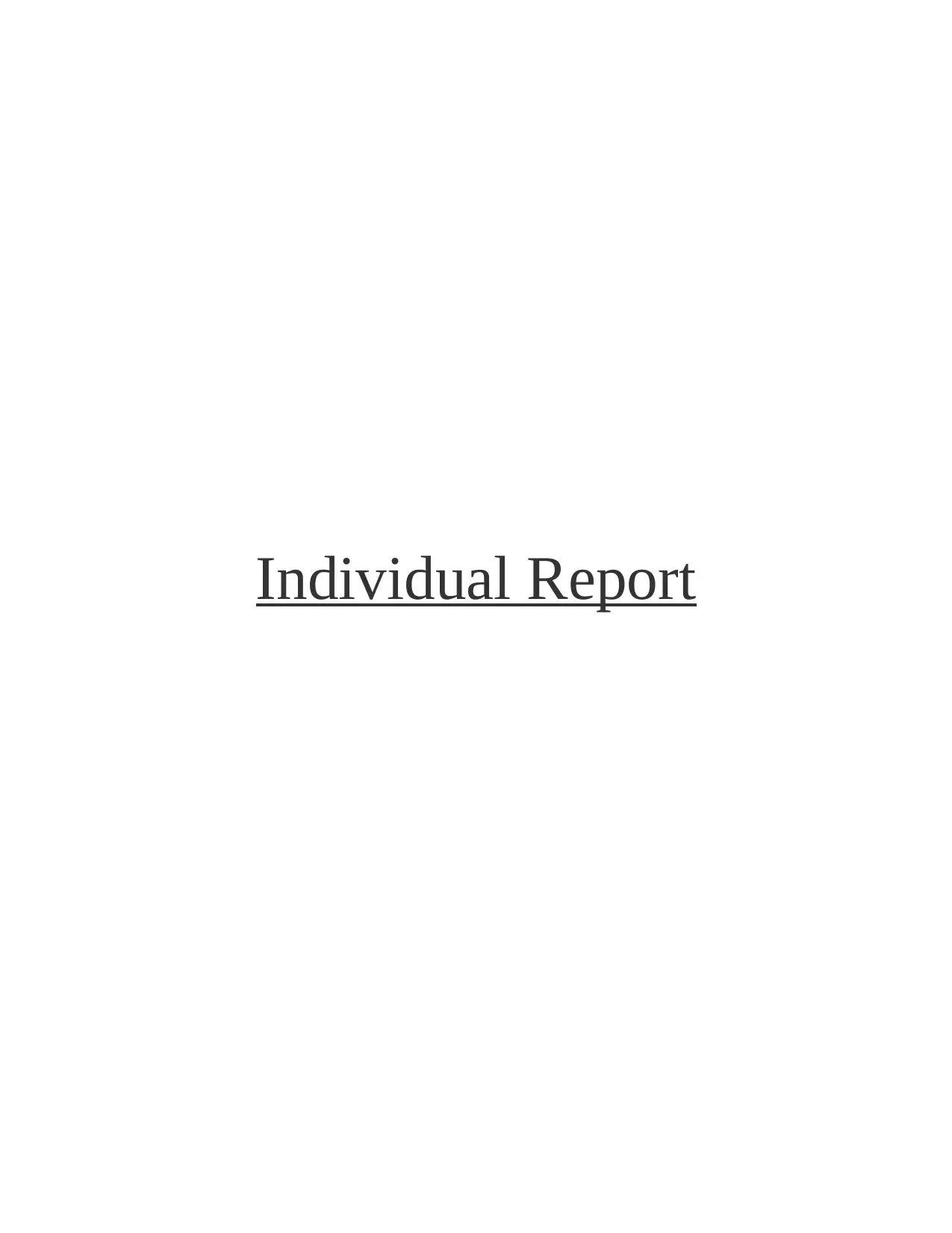
Individual Report
Paraphrase This Document
Need a fresh take? Get an instant paraphrase of this document with our AI Paraphraser
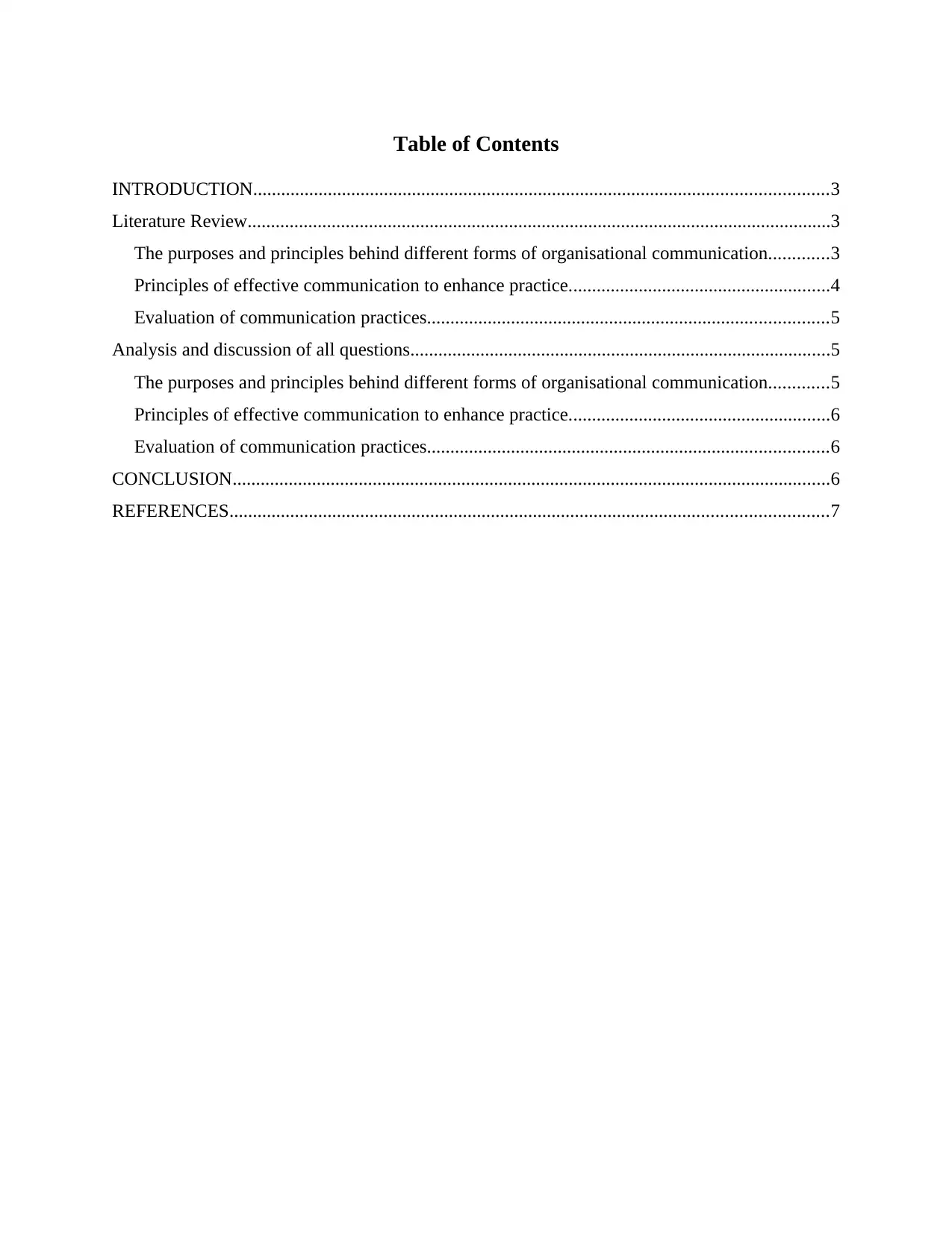
Table of Contents
INTRODUCTION...........................................................................................................................3
Literature Review.............................................................................................................................3
The purposes and principles behind different forms of organisational communication.............3
Principles of effective communication to enhance practice........................................................4
Evaluation of communication practices......................................................................................5
Analysis and discussion of all questions..........................................................................................5
The purposes and principles behind different forms of organisational communication.............5
Principles of effective communication to enhance practice........................................................6
Evaluation of communication practices......................................................................................6
CONCLUSION................................................................................................................................6
REFERENCES................................................................................................................................7
INTRODUCTION...........................................................................................................................3
Literature Review.............................................................................................................................3
The purposes and principles behind different forms of organisational communication.............3
Principles of effective communication to enhance practice........................................................4
Evaluation of communication practices......................................................................................5
Analysis and discussion of all questions..........................................................................................5
The purposes and principles behind different forms of organisational communication.............5
Principles of effective communication to enhance practice........................................................6
Evaluation of communication practices......................................................................................6
CONCLUSION................................................................................................................................6
REFERENCES................................................................................................................................7
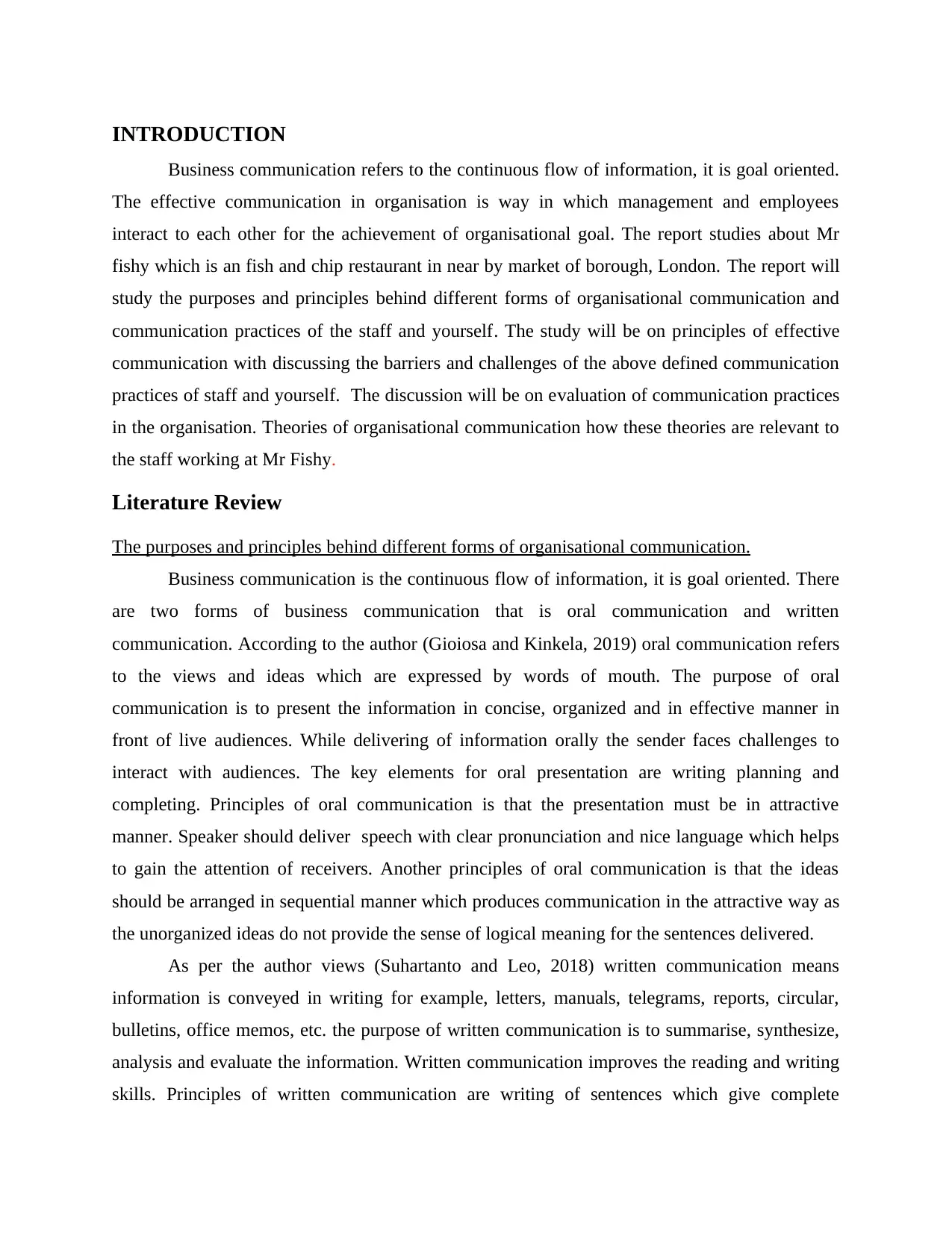
INTRODUCTION
Business communication refers to the continuous flow of information, it is goal oriented.
The effective communication in organisation is way in which management and employees
interact to each other for the achievement of organisational goal. The report studies about Mr
fishy which is an fish and chip restaurant in near by market of borough, London. The report will
study the purposes and principles behind different forms of organisational communication and
communication practices of the staff and yourself. The study will be on principles of effective
communication with discussing the barriers and challenges of the above defined communication
practices of staff and yourself. The discussion will be on evaluation of communication practices
in the organisation. Theories of organisational communication how these theories are relevant to
the staff working at Mr Fishy.
Literature Review
The purposes and principles behind different forms of organisational communication.
Business communication is the continuous flow of information, it is goal oriented. There
are two forms of business communication that is oral communication and written
communication. According to the author (Gioiosa and Kinkela, 2019) oral communication refers
to the views and ideas which are expressed by words of mouth. The purpose of oral
communication is to present the information in concise, organized and in effective manner in
front of live audiences. While delivering of information orally the sender faces challenges to
interact with audiences. The key elements for oral presentation are writing planning and
completing. Principles of oral communication is that the presentation must be in attractive
manner. Speaker should deliver speech with clear pronunciation and nice language which helps
to gain the attention of receivers. Another principles of oral communication is that the ideas
should be arranged in sequential manner which produces communication in the attractive way as
the unorganized ideas do not provide the sense of logical meaning for the sentences delivered.
As per the author views (Suhartanto and Leo, 2018) written communication means
information is conveyed in writing for example, letters, manuals, telegrams, reports, circular,
bulletins, office memos, etc. the purpose of written communication is to summarise, synthesize,
analysis and evaluate the information. Written communication improves the reading and writing
skills. Principles of written communication are writing of sentences which give complete
Business communication refers to the continuous flow of information, it is goal oriented.
The effective communication in organisation is way in which management and employees
interact to each other for the achievement of organisational goal. The report studies about Mr
fishy which is an fish and chip restaurant in near by market of borough, London. The report will
study the purposes and principles behind different forms of organisational communication and
communication practices of the staff and yourself. The study will be on principles of effective
communication with discussing the barriers and challenges of the above defined communication
practices of staff and yourself. The discussion will be on evaluation of communication practices
in the organisation. Theories of organisational communication how these theories are relevant to
the staff working at Mr Fishy.
Literature Review
The purposes and principles behind different forms of organisational communication.
Business communication is the continuous flow of information, it is goal oriented. There
are two forms of business communication that is oral communication and written
communication. According to the author (Gioiosa and Kinkela, 2019) oral communication refers
to the views and ideas which are expressed by words of mouth. The purpose of oral
communication is to present the information in concise, organized and in effective manner in
front of live audiences. While delivering of information orally the sender faces challenges to
interact with audiences. The key elements for oral presentation are writing planning and
completing. Principles of oral communication is that the presentation must be in attractive
manner. Speaker should deliver speech with clear pronunciation and nice language which helps
to gain the attention of receivers. Another principles of oral communication is that the ideas
should be arranged in sequential manner which produces communication in the attractive way as
the unorganized ideas do not provide the sense of logical meaning for the sentences delivered.
As per the author views (Suhartanto and Leo, 2018) written communication means
information is conveyed in writing for example, letters, manuals, telegrams, reports, circular,
bulletins, office memos, etc. the purpose of written communication is to summarise, synthesize,
analysis and evaluate the information. Written communication improves the reading and writing
skills. Principles of written communication are writing of sentences which give complete
⊘ This is a preview!⊘
Do you want full access?
Subscribe today to unlock all pages.

Trusted by 1+ million students worldwide
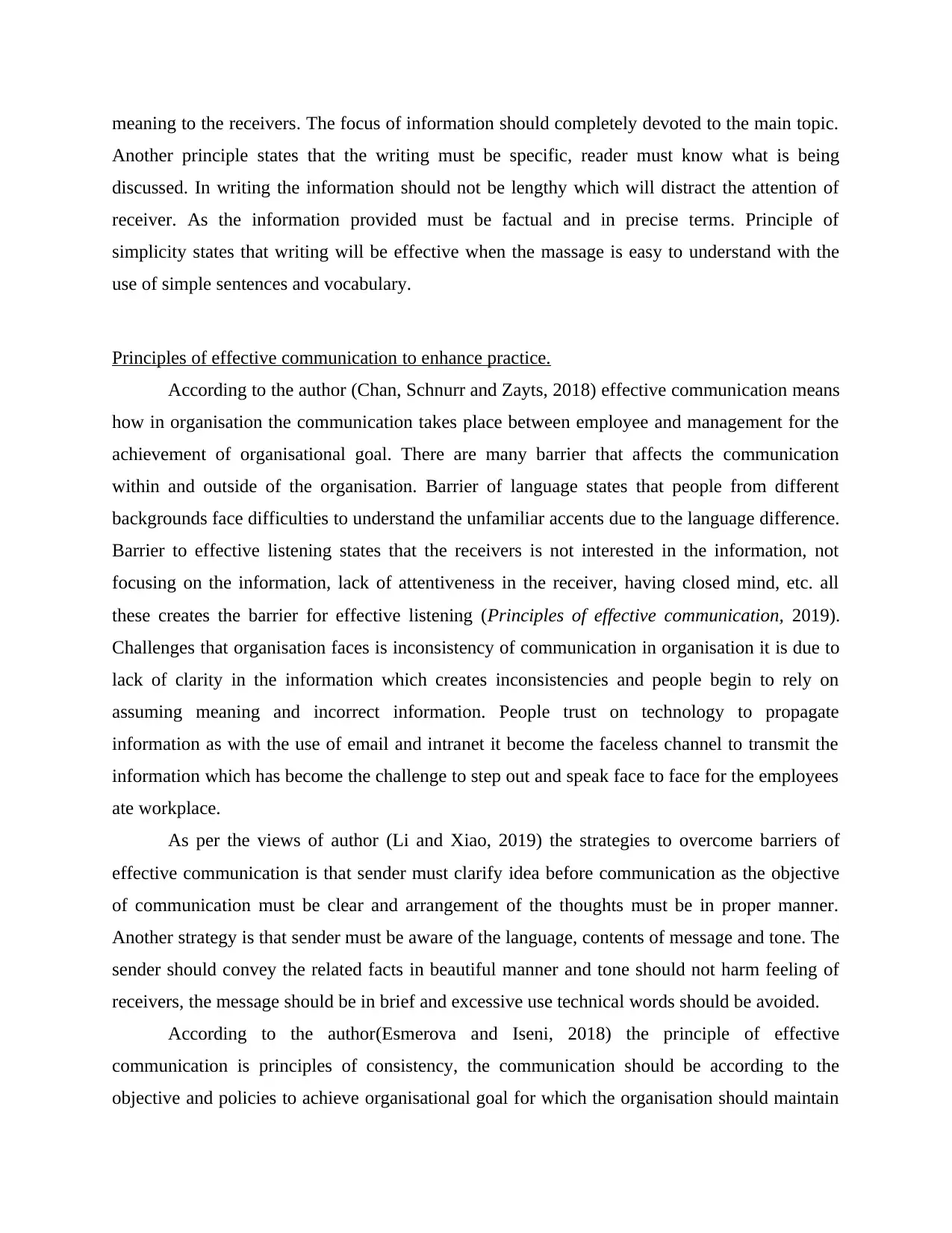
meaning to the receivers. The focus of information should completely devoted to the main topic.
Another principle states that the writing must be specific, reader must know what is being
discussed. In writing the information should not be lengthy which will distract the attention of
receiver. As the information provided must be factual and in precise terms. Principle of
simplicity states that writing will be effective when the massage is easy to understand with the
use of simple sentences and vocabulary.
Principles of effective communication to enhance practice.
According to the author (Chan, Schnurr and Zayts, 2018) effective communication means
how in organisation the communication takes place between employee and management for the
achievement of organisational goal. There are many barrier that affects the communication
within and outside of the organisation. Barrier of language states that people from different
backgrounds face difficulties to understand the unfamiliar accents due to the language difference.
Barrier to effective listening states that the receivers is not interested in the information, not
focusing on the information, lack of attentiveness in the receiver, having closed mind, etc. all
these creates the barrier for effective listening (Principles of effective communication, 2019).
Challenges that organisation faces is inconsistency of communication in organisation it is due to
lack of clarity in the information which creates inconsistencies and people begin to rely on
assuming meaning and incorrect information. People trust on technology to propagate
information as with the use of email and intranet it become the faceless channel to transmit the
information which has become the challenge to step out and speak face to face for the employees
ate workplace.
As per the views of author (Li and Xiao, 2019) the strategies to overcome barriers of
effective communication is that sender must clarify idea before communication as the objective
of communication must be clear and arrangement of the thoughts must be in proper manner.
Another strategy is that sender must be aware of the language, contents of message and tone. The
sender should convey the related facts in beautiful manner and tone should not harm feeling of
receivers, the message should be in brief and excessive use technical words should be avoided.
According to the author(Esmerova and Iseni, 2018) the principle of effective
communication is principles of consistency, the communication should be according to the
objective and policies to achieve organisational goal for which the organisation should maintain
Another principle states that the writing must be specific, reader must know what is being
discussed. In writing the information should not be lengthy which will distract the attention of
receiver. As the information provided must be factual and in precise terms. Principle of
simplicity states that writing will be effective when the massage is easy to understand with the
use of simple sentences and vocabulary.
Principles of effective communication to enhance practice.
According to the author (Chan, Schnurr and Zayts, 2018) effective communication means
how in organisation the communication takes place between employee and management for the
achievement of organisational goal. There are many barrier that affects the communication
within and outside of the organisation. Barrier of language states that people from different
backgrounds face difficulties to understand the unfamiliar accents due to the language difference.
Barrier to effective listening states that the receivers is not interested in the information, not
focusing on the information, lack of attentiveness in the receiver, having closed mind, etc. all
these creates the barrier for effective listening (Principles of effective communication, 2019).
Challenges that organisation faces is inconsistency of communication in organisation it is due to
lack of clarity in the information which creates inconsistencies and people begin to rely on
assuming meaning and incorrect information. People trust on technology to propagate
information as with the use of email and intranet it become the faceless channel to transmit the
information which has become the challenge to step out and speak face to face for the employees
ate workplace.
As per the views of author (Li and Xiao, 2019) the strategies to overcome barriers of
effective communication is that sender must clarify idea before communication as the objective
of communication must be clear and arrangement of the thoughts must be in proper manner.
Another strategy is that sender must be aware of the language, contents of message and tone. The
sender should convey the related facts in beautiful manner and tone should not harm feeling of
receivers, the message should be in brief and excessive use technical words should be avoided.
According to the author(Esmerova and Iseni, 2018) the principle of effective
communication is principles of consistency, the communication should be according to the
objective and policies to achieve organisational goal for which the organisation should maintain
Paraphrase This Document
Need a fresh take? Get an instant paraphrase of this document with our AI Paraphraser
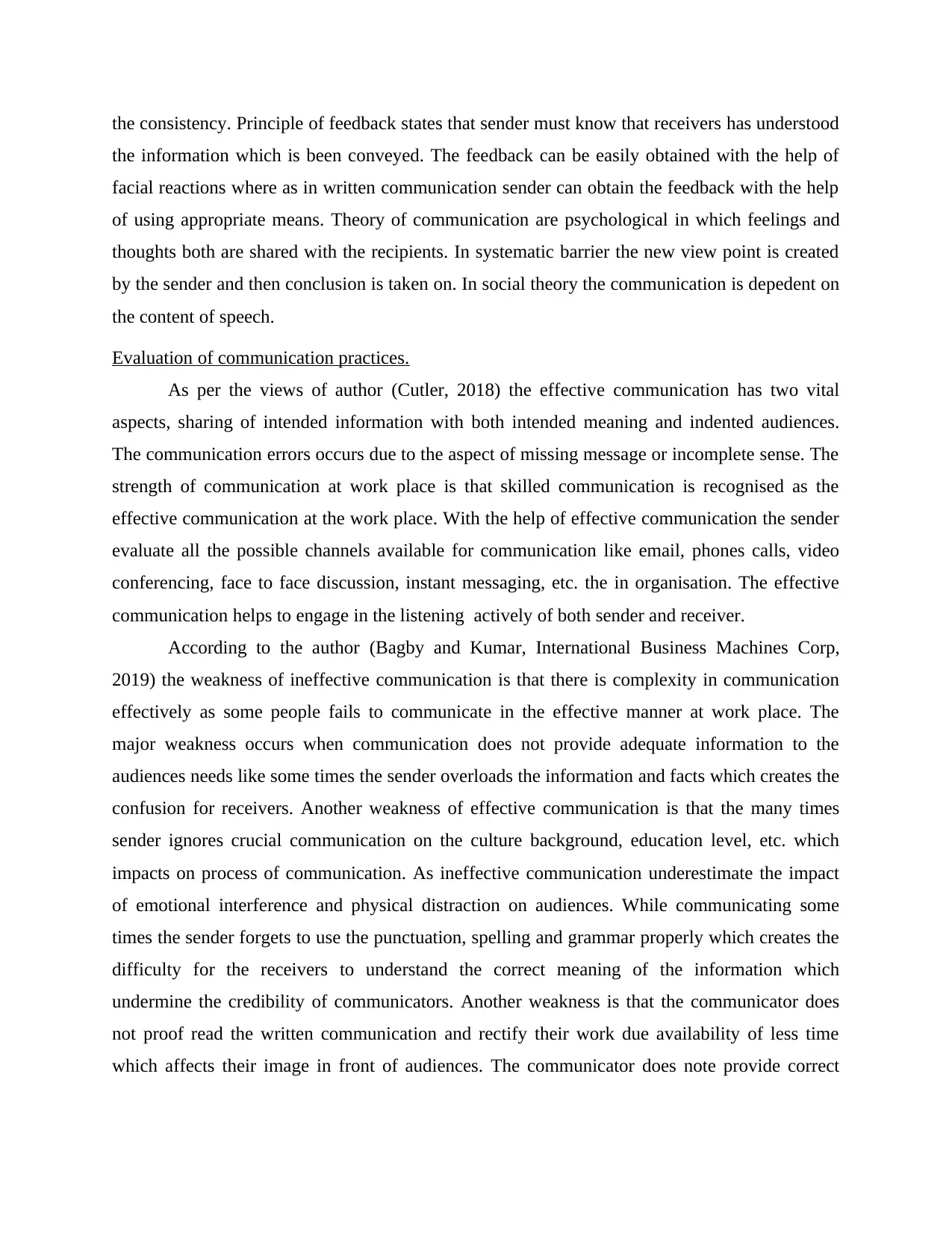
the consistency. Principle of feedback states that sender must know that receivers has understood
the information which is been conveyed. The feedback can be easily obtained with the help of
facial reactions where as in written communication sender can obtain the feedback with the help
of using appropriate means. Theory of communication are psychological in which feelings and
thoughts both are shared with the recipients. In systematic barrier the new view point is created
by the sender and then conclusion is taken on. In social theory the communication is depedent on
the content of speech.
Evaluation of communication practices.
As per the views of author (Cutler, 2018) the effective communication has two vital
aspects, sharing of intended information with both intended meaning and indented audiences.
The communication errors occurs due to the aspect of missing message or incomplete sense. The
strength of communication at work place is that skilled communication is recognised as the
effective communication at the work place. With the help of effective communication the sender
evaluate all the possible channels available for communication like email, phones calls, video
conferencing, face to face discussion, instant messaging, etc. the in organisation. The effective
communication helps to engage in the listening actively of both sender and receiver.
According to the author (Bagby and Kumar, International Business Machines Corp,
2019) the weakness of ineffective communication is that there is complexity in communication
effectively as some people fails to communicate in the effective manner at work place. The
major weakness occurs when communication does not provide adequate information to the
audiences needs like some times the sender overloads the information and facts which creates the
confusion for receivers. Another weakness of effective communication is that the many times
sender ignores crucial communication on the culture background, education level, etc. which
impacts on process of communication. As ineffective communication underestimate the impact
of emotional interference and physical distraction on audiences. While communicating some
times the sender forgets to use the punctuation, spelling and grammar properly which creates the
difficulty for the receivers to understand the correct meaning of the information which
undermine the credibility of communicators. Another weakness is that the communicator does
not proof read the written communication and rectify their work due availability of less time
which affects their image in front of audiences. The communicator does note provide correct
the information which is been conveyed. The feedback can be easily obtained with the help of
facial reactions where as in written communication sender can obtain the feedback with the help
of using appropriate means. Theory of communication are psychological in which feelings and
thoughts both are shared with the recipients. In systematic barrier the new view point is created
by the sender and then conclusion is taken on. In social theory the communication is depedent on
the content of speech.
Evaluation of communication practices.
As per the views of author (Cutler, 2018) the effective communication has two vital
aspects, sharing of intended information with both intended meaning and indented audiences.
The communication errors occurs due to the aspect of missing message or incomplete sense. The
strength of communication at work place is that skilled communication is recognised as the
effective communication at the work place. With the help of effective communication the sender
evaluate all the possible channels available for communication like email, phones calls, video
conferencing, face to face discussion, instant messaging, etc. the in organisation. The effective
communication helps to engage in the listening actively of both sender and receiver.
According to the author (Bagby and Kumar, International Business Machines Corp,
2019) the weakness of ineffective communication is that there is complexity in communication
effectively as some people fails to communicate in the effective manner at work place. The
major weakness occurs when communication does not provide adequate information to the
audiences needs like some times the sender overloads the information and facts which creates the
confusion for receivers. Another weakness of effective communication is that the many times
sender ignores crucial communication on the culture background, education level, etc. which
impacts on process of communication. As ineffective communication underestimate the impact
of emotional interference and physical distraction on audiences. While communicating some
times the sender forgets to use the punctuation, spelling and grammar properly which creates the
difficulty for the receivers to understand the correct meaning of the information which
undermine the credibility of communicators. Another weakness is that the communicator does
not proof read the written communication and rectify their work due availability of less time
which affects their image in front of audiences. The communicator does note provide correct
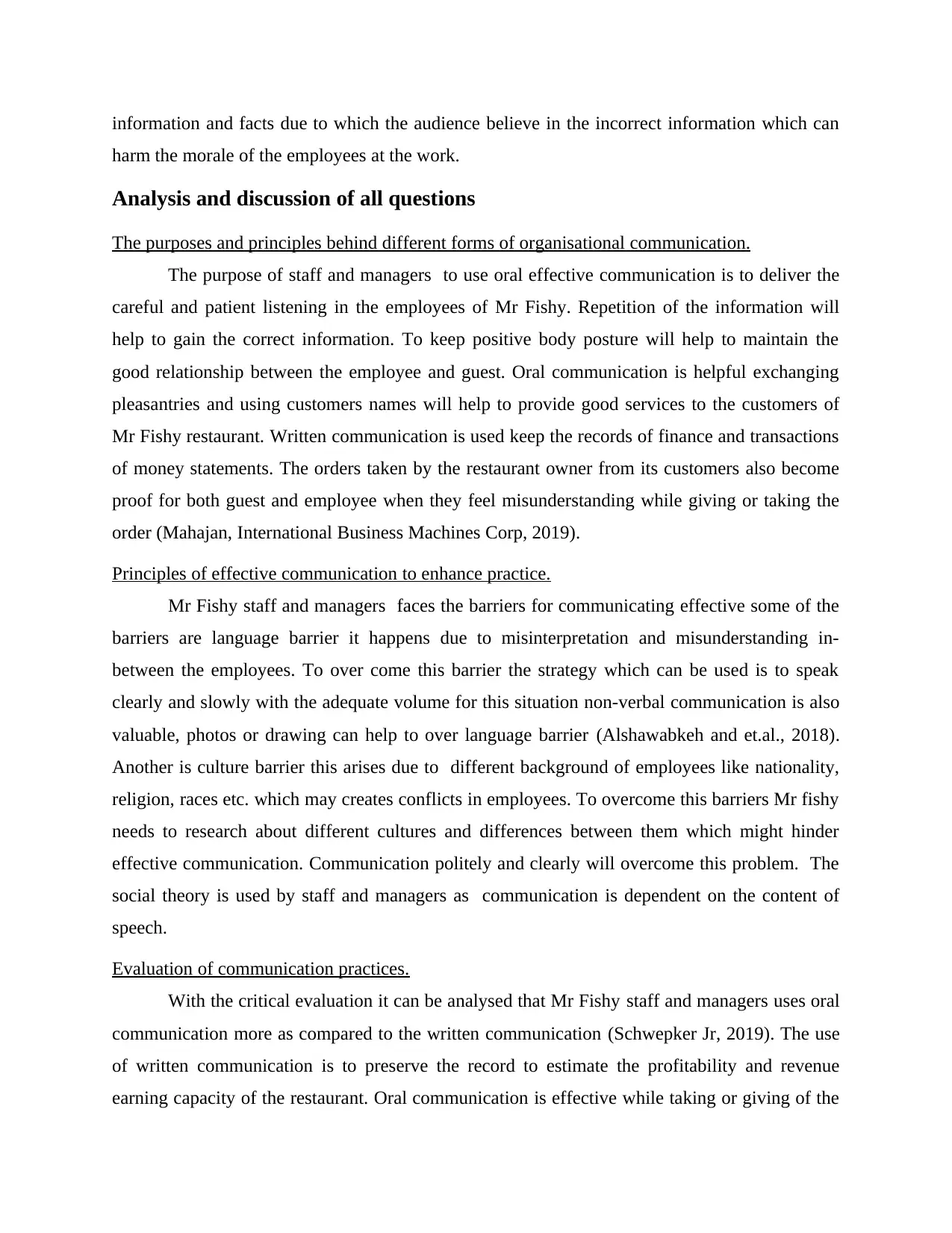
information and facts due to which the audience believe in the incorrect information which can
harm the morale of the employees at the work.
Analysis and discussion of all questions
The purposes and principles behind different forms of organisational communication.
The purpose of staff and managers to use oral effective communication is to deliver the
careful and patient listening in the employees of Mr Fishy. Repetition of the information will
help to gain the correct information. To keep positive body posture will help to maintain the
good relationship between the employee and guest. Oral communication is helpful exchanging
pleasantries and using customers names will help to provide good services to the customers of
Mr Fishy restaurant. Written communication is used keep the records of finance and transactions
of money statements. The orders taken by the restaurant owner from its customers also become
proof for both guest and employee when they feel misunderstanding while giving or taking the
order (Mahajan, International Business Machines Corp, 2019).
Principles of effective communication to enhance practice.
Mr Fishy staff and managers faces the barriers for communicating effective some of the
barriers are language barrier it happens due to misinterpretation and misunderstanding in-
between the employees. To over come this barrier the strategy which can be used is to speak
clearly and slowly with the adequate volume for this situation non-verbal communication is also
valuable, photos or drawing can help to over language barrier (Alshawabkeh and et.al., 2018).
Another is culture barrier this arises due to different background of employees like nationality,
religion, races etc. which may creates conflicts in employees. To overcome this barriers Mr fishy
needs to research about different cultures and differences between them which might hinder
effective communication. Communication politely and clearly will overcome this problem. The
social theory is used by staff and managers as communication is dependent on the content of
speech.
Evaluation of communication practices.
With the critical evaluation it can be analysed that Mr Fishy staff and managers uses oral
communication more as compared to the written communication (Schwepker Jr, 2019). The use
of written communication is to preserve the record to estimate the profitability and revenue
earning capacity of the restaurant. Oral communication is effective while taking or giving of the
harm the morale of the employees at the work.
Analysis and discussion of all questions
The purposes and principles behind different forms of organisational communication.
The purpose of staff and managers to use oral effective communication is to deliver the
careful and patient listening in the employees of Mr Fishy. Repetition of the information will
help to gain the correct information. To keep positive body posture will help to maintain the
good relationship between the employee and guest. Oral communication is helpful exchanging
pleasantries and using customers names will help to provide good services to the customers of
Mr Fishy restaurant. Written communication is used keep the records of finance and transactions
of money statements. The orders taken by the restaurant owner from its customers also become
proof for both guest and employee when they feel misunderstanding while giving or taking the
order (Mahajan, International Business Machines Corp, 2019).
Principles of effective communication to enhance practice.
Mr Fishy staff and managers faces the barriers for communicating effective some of the
barriers are language barrier it happens due to misinterpretation and misunderstanding in-
between the employees. To over come this barrier the strategy which can be used is to speak
clearly and slowly with the adequate volume for this situation non-verbal communication is also
valuable, photos or drawing can help to over language barrier (Alshawabkeh and et.al., 2018).
Another is culture barrier this arises due to different background of employees like nationality,
religion, races etc. which may creates conflicts in employees. To overcome this barriers Mr fishy
needs to research about different cultures and differences between them which might hinder
effective communication. Communication politely and clearly will overcome this problem. The
social theory is used by staff and managers as communication is dependent on the content of
speech.
Evaluation of communication practices.
With the critical evaluation it can be analysed that Mr Fishy staff and managers uses oral
communication more as compared to the written communication (Schwepker Jr, 2019). The use
of written communication is to preserve the record to estimate the profitability and revenue
earning capacity of the restaurant. Oral communication is effective while taking or giving of the
⊘ This is a preview!⊘
Do you want full access?
Subscribe today to unlock all pages.

Trusted by 1+ million students worldwide
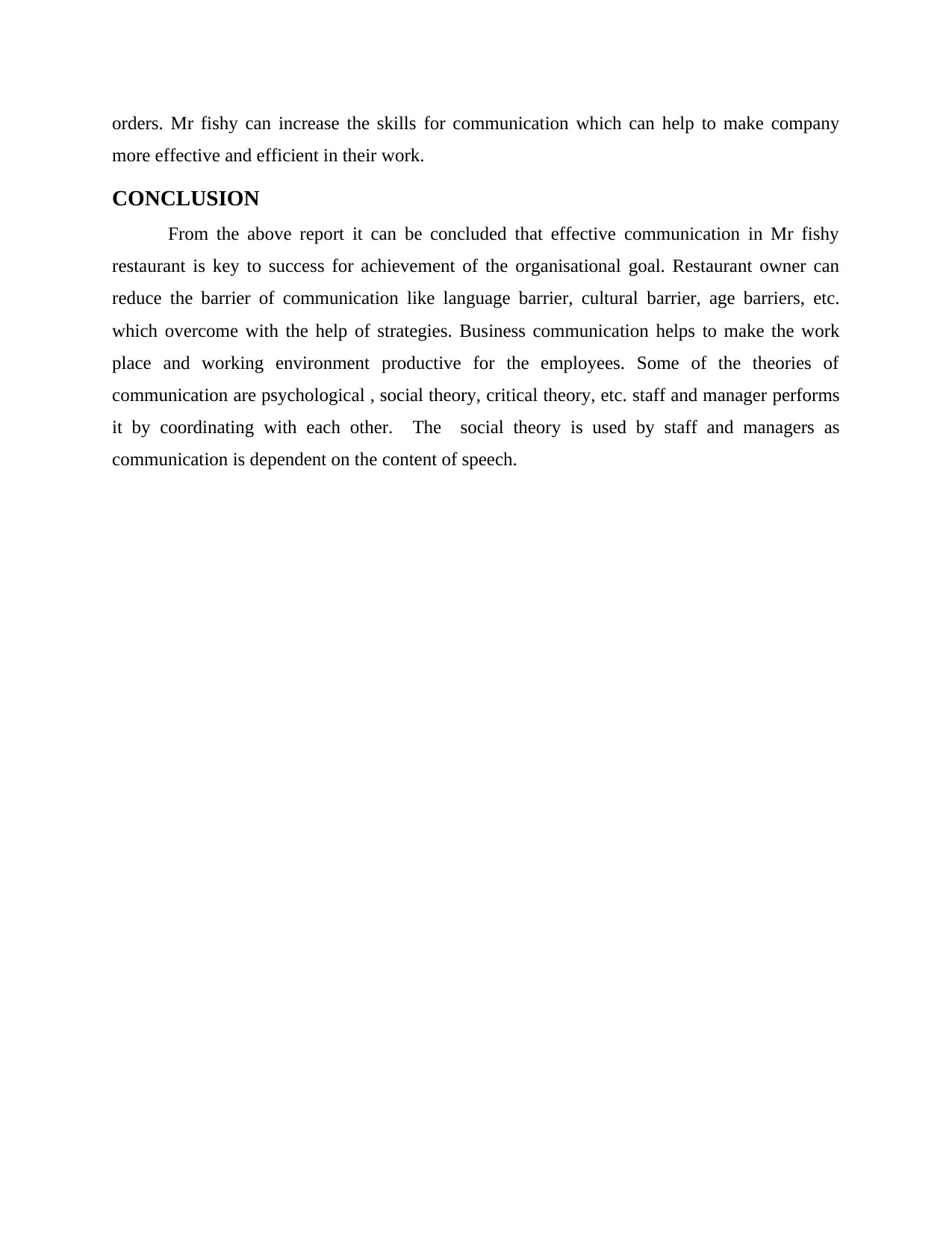
orders. Mr fishy can increase the skills for communication which can help to make company
more effective and efficient in their work.
CONCLUSION
From the above report it can be concluded that effective communication in Mr fishy
restaurant is key to success for achievement of the organisational goal. Restaurant owner can
reduce the barrier of communication like language barrier, cultural barrier, age barriers, etc.
which overcome with the help of strategies. Business communication helps to make the work
place and working environment productive for the employees. Some of the theories of
communication are psychological , social theory, critical theory, etc. staff and manager performs
it by coordinating with each other. The social theory is used by staff and managers as
communication is dependent on the content of speech.
more effective and efficient in their work.
CONCLUSION
From the above report it can be concluded that effective communication in Mr fishy
restaurant is key to success for achievement of the organisational goal. Restaurant owner can
reduce the barrier of communication like language barrier, cultural barrier, age barriers, etc.
which overcome with the help of strategies. Business communication helps to make the work
place and working environment productive for the employees. Some of the theories of
communication are psychological , social theory, critical theory, etc. staff and manager performs
it by coordinating with each other. The social theory is used by staff and managers as
communication is dependent on the content of speech.
Paraphrase This Document
Need a fresh take? Get an instant paraphrase of this document with our AI Paraphraser
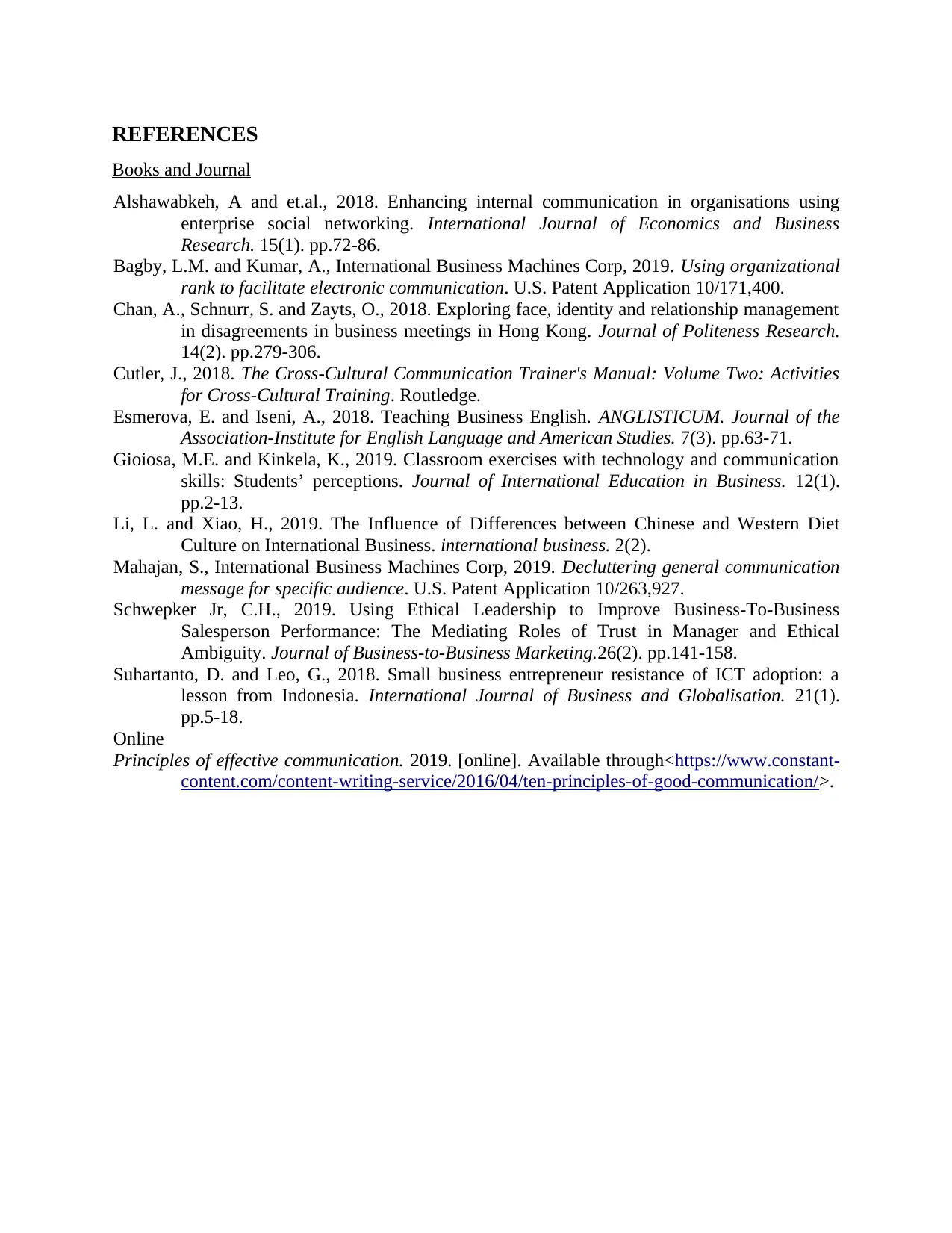
REFERENCES
Books and Journal
Alshawabkeh, A and et.al., 2018. Enhancing internal communication in organisations using
enterprise social networking. International Journal of Economics and Business
Research. 15(1). pp.72-86.
Bagby, L.M. and Kumar, A., International Business Machines Corp, 2019. Using organizational
rank to facilitate electronic communication. U.S. Patent Application 10/171,400.
Chan, A., Schnurr, S. and Zayts, O., 2018. Exploring face, identity and relationship management
in disagreements in business meetings in Hong Kong. Journal of Politeness Research.
14(2). pp.279-306.
Cutler, J., 2018. The Cross-Cultural Communication Trainer's Manual: Volume Two: Activities
for Cross-Cultural Training. Routledge.
Esmerova, E. and Iseni, A., 2018. Teaching Business English. ANGLISTICUM. Journal of the
Association-Institute for English Language and American Studies. 7(3). pp.63-71.
Gioiosa, M.E. and Kinkela, K., 2019. Classroom exercises with technology and communication
skills: Students’ perceptions. Journal of International Education in Business. 12(1).
pp.2-13.
Li, L. and Xiao, H., 2019. The Influence of Differences between Chinese and Western Diet
Culture on International Business. international business. 2(2).
Mahajan, S., International Business Machines Corp, 2019. Decluttering general communication
message for specific audience. U.S. Patent Application 10/263,927.
Schwepker Jr, C.H., 2019. Using Ethical Leadership to Improve Business-To-Business
Salesperson Performance: The Mediating Roles of Trust in Manager and Ethical
Ambiguity. Journal of Business-to-Business Marketing.26(2). pp.141-158.
Suhartanto, D. and Leo, G., 2018. Small business entrepreneur resistance of ICT adoption: a
lesson from Indonesia. International Journal of Business and Globalisation. 21(1).
pp.5-18.
Online
Principles of effective communication. 2019. [online]. Available through<https://www.constant-
content.com/content-writing-service/2016/04/ten-principles-of-good-communication/>.
Books and Journal
Alshawabkeh, A and et.al., 2018. Enhancing internal communication in organisations using
enterprise social networking. International Journal of Economics and Business
Research. 15(1). pp.72-86.
Bagby, L.M. and Kumar, A., International Business Machines Corp, 2019. Using organizational
rank to facilitate electronic communication. U.S. Patent Application 10/171,400.
Chan, A., Schnurr, S. and Zayts, O., 2018. Exploring face, identity and relationship management
in disagreements in business meetings in Hong Kong. Journal of Politeness Research.
14(2). pp.279-306.
Cutler, J., 2018. The Cross-Cultural Communication Trainer's Manual: Volume Two: Activities
for Cross-Cultural Training. Routledge.
Esmerova, E. and Iseni, A., 2018. Teaching Business English. ANGLISTICUM. Journal of the
Association-Institute for English Language and American Studies. 7(3). pp.63-71.
Gioiosa, M.E. and Kinkela, K., 2019. Classroom exercises with technology and communication
skills: Students’ perceptions. Journal of International Education in Business. 12(1).
pp.2-13.
Li, L. and Xiao, H., 2019. The Influence of Differences between Chinese and Western Diet
Culture on International Business. international business. 2(2).
Mahajan, S., International Business Machines Corp, 2019. Decluttering general communication
message for specific audience. U.S. Patent Application 10/263,927.
Schwepker Jr, C.H., 2019. Using Ethical Leadership to Improve Business-To-Business
Salesperson Performance: The Mediating Roles of Trust in Manager and Ethical
Ambiguity. Journal of Business-to-Business Marketing.26(2). pp.141-158.
Suhartanto, D. and Leo, G., 2018. Small business entrepreneur resistance of ICT adoption: a
lesson from Indonesia. International Journal of Business and Globalisation. 21(1).
pp.5-18.
Online
Principles of effective communication. 2019. [online]. Available through<https://www.constant-
content.com/content-writing-service/2016/04/ten-principles-of-good-communication/>.
1 out of 8
Related Documents
Your All-in-One AI-Powered Toolkit for Academic Success.
+13062052269
info@desklib.com
Available 24*7 on WhatsApp / Email
![[object Object]](/_next/static/media/star-bottom.7253800d.svg)
Unlock your academic potential
Copyright © 2020–2025 A2Z Services. All Rights Reserved. Developed and managed by ZUCOL.





